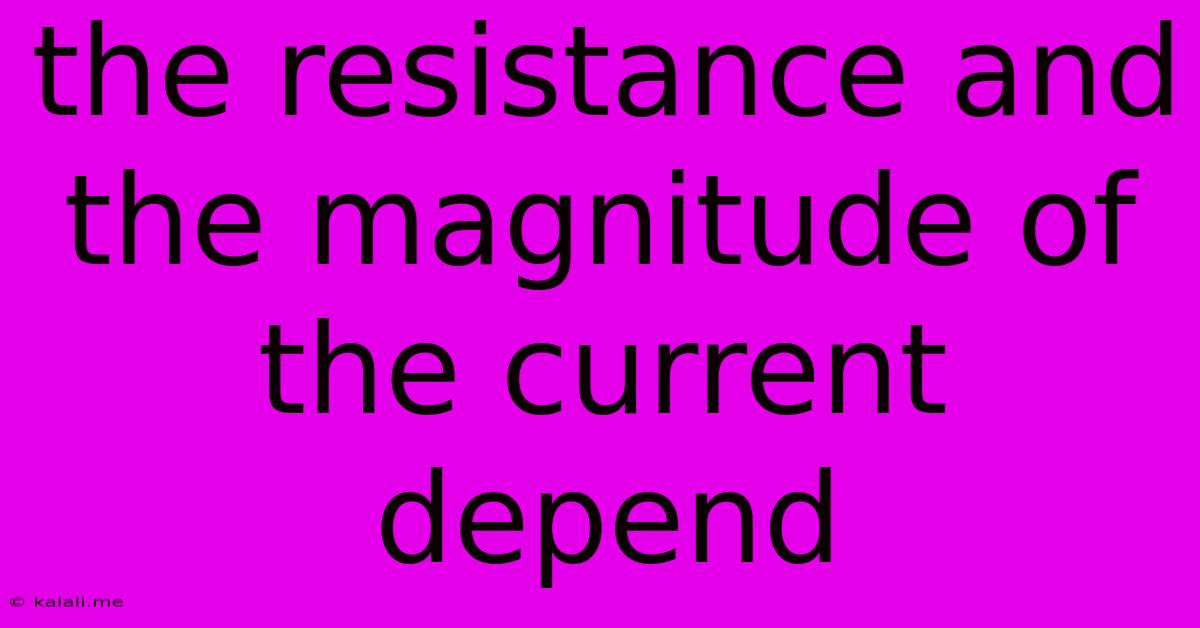The Resistance And The Magnitude Of The Current Depend
Kalali
Jun 15, 2025 · 3 min read

Table of Contents
The Resistance and Magnitude of Current: A Deep Dive into Ohm's Law
Understanding the relationship between resistance, voltage, and current is fundamental to comprehending basic electricity. This article will delve into Ohm's Law, exploring how resistance influences the magnitude of current flow in a circuit. We'll also examine factors influencing resistance and practical applications of this crucial relationship.
What is Resistance?
Resistance, measured in ohms (Ω), is the opposition a material offers to the flow of electric current. Think of it as friction in a water pipe – the narrower the pipe, the greater the resistance to water flow. Similarly, a material with high resistance impedes the movement of electrons, resulting in a smaller current for a given voltage. This opposition converts electrical energy into heat, a phenomenon known as Joule heating. Materials with low resistance are called conductors (like copper), while those with high resistance are insulators (like rubber). Between these extremes lie semiconductors, whose resistance can be carefully controlled.
Ohm's Law: The Foundation of Current Calculation
Ohm's Law is the cornerstone of understanding the relationship between voltage (V), current (I), and resistance (R). It states that:
V = I × R
This simple yet powerful equation allows us to calculate any one of these three values if we know the other two. Let's break down its implications:
-
Higher Resistance, Lower Current: For a fixed voltage, increasing the resistance leads to a decrease in current. The electrons encounter more opposition, reducing the rate of flow.
-
Higher Voltage, Higher Current: For a fixed resistance, increasing the voltage results in an increased current. A higher voltage provides more "push" for the electrons, overcoming the resistance and leading to a greater flow.
-
Constant Resistance: Ohm's Law holds true only when the resistance remains constant. In reality, the resistance of some materials can change with temperature, voltage, or other factors. These non-ohmic materials don't strictly adhere to this linear relationship.
Factors Affecting Resistance
Several factors influence the resistance of a material:
-
Material: Different materials possess inherent resistance properties. Conductors like copper have low resistance, while insulators like rubber have high resistance.
-
Length: The longer the conductor, the greater the resistance. Electrons have to travel a longer distance, encountering more obstacles.
-
Cross-sectional Area: A thicker conductor offers less resistance than a thinner one. A larger area provides more pathways for electron flow.
-
Temperature: For most conductors, resistance increases with temperature. Increased thermal vibrations of atoms impede electron movement.
Practical Applications
Understanding the relationship between resistance and current is crucial in numerous applications:
-
Circuit Design: Engineers use resistors to control the current flow in electronic circuits, ensuring components operate within their specified parameters.
-
Heating Elements: Resistance is exploited in appliances like toasters and heaters. The high resistance of the heating element generates significant heat when current flows through it.
-
Sensors: Changes in resistance due to temperature, pressure, or light are used in various sensors to measure physical quantities.
Conclusion
The interplay between resistance and current, governed by Ohm's Law, is fundamental to electrical engineering and numerous other fields. By understanding how resistance influences current magnitude and the factors affecting resistance, we can design, analyze, and troubleshoot a wide range of electrical systems. This knowledge empowers us to utilize the power of electricity safely and efficiently.
Latest Posts
Latest Posts
-
What Is The First Five Multiples Of 9
Jun 16, 2025
-
Distinguish Between A Neuron And A Neuroglial Cell
Jun 16, 2025
-
Which Of The Following Is True About Compounds
Jun 16, 2025
-
45 Is What Percent Of 225
Jun 16, 2025
-
Give A Suitable Title To The Above Passage
Jun 16, 2025
Related Post
Thank you for visiting our website which covers about The Resistance And The Magnitude Of The Current Depend . We hope the information provided has been useful to you. Feel free to contact us if you have any questions or need further assistance. See you next time and don't miss to bookmark.